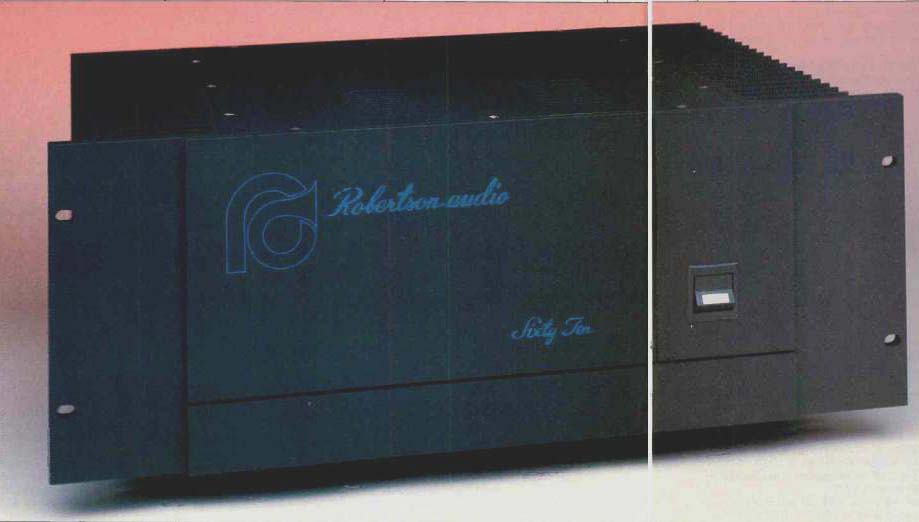
Manufacturer's Specifications:
Power Output: From 20 Hz to 20 kHz, both channels driven, 200 watts into 8-ohm loads, 400 watts into 4-ohm loads; at 1 kHz, one channel driven, 800 watts into 2-ohm load, 1,600 watts into 1-ohm load.
Frequency Response: 0.5 Hz to 250 kHz, +0, -3 dB, at rated power level.
THD: 0.1%, 23 Hz to 20 kHz, at 200 watts.
IM Distortion: 0.005%.
Transient IM Distortion: 0.001%.
Rise and Fall Time: 1.2 1.13.
Slew Rate: 256 V/µS.
S/N Ratio: 90 dB, unweighted, wideband.
Input Impedance: 51 kilohms.
Input Sensitivity: 2V.
Damping Factor: 800, at 50 Hz.
Channel Separation: 90 dB.
Phase: Non-inverting.
Power Requirements: 110 to 220 V a.c. or 220 to 240 V a.c., 50 to 60 Hz.
Maximum Power Consumption: 1,300 watts.
Dimensions: 19 in. W x 14 1/4 in. D x 7 in. H (48.3 cm x 36.2 cm x 17.8 cm); rack-mountable.
Weight: 65 lbs. (29.5 kg).
Price: $2,550.
Company Address: P.O. Box 8449, Van Nuys, Cal. 91409, USA.
The Sixty Ten is the larger of two power amplifiers in the Robertson line of audio electronics. Rated at 200 watts per channel, it is a very well-made, attractive hunk of amplifier.
In its physical construction, the amp uses the front panel as a foundation on which to build. A lip extends about 3/4 inch back from all sides of the front panel, and the panels and sub-assemblies that make up the top, bottom and sides of the amplifier bolt to that lip. The design is modular, with each amplifier channel and its heat-sink making up one side of the amplifier and wrapping around to the rear. The amplifier modules can be removed by simply unbolting them and disconnecting four wires-not even a soldering iron is required. These four wires (+ V,-V, common and amp output) are extremely short and go directly to the filter-capacitor assembly, thereby avoiding the losses incurred in the long runs between capacitors and amp circuitry found in some other amplifiers.
The rear panel is divided equally between the amplifier channels and the central power-supply section. Each channel has its own signal-input jack, speaker fuse, and pair of five-way binding posts for output. Externally, the center section holds a three-pin female line-cord connector and a line fuse. Inside, the central section is bolted to a plate which holds the four filter capacitors; the other end of this plate bolts to the power transformer which, in turn, bolts to the rear panel. Quarter-inch sections of bar stock are attached to the amplifier modules and rear panels, top and bottom; the top and bottom covers are screwed to these sections and to the front panel's top and bottom lips. The front panel's sole control is a single, illuminated power on/off rocker switch.
The amplifier modules appear to have been designed for the shortest possible signal paths from input to output. In each module, 10 large, plastic Sanken output transistors and two TO-220-cased driver transistors surround a double-sided p.c. board. The board is a rectangle with its four corners cut off at 45° angles; input and output connections are near the center of the board.
In the power-supply section, the common terminals of the four 33,000-uF/100-V filter capacitors are connected by a gold-plated plate. Two full-wave bridge rectifiers, one per channel, are mounted on this plate. A 50-watt resistor in series with the power transformer primary reduces in-rush current at turn-on. After about 2 or 3S, a time-delay relay (mounted, like the resistor, just inside the front panel) shorts the resistor out.
Robertson makes a point of claiming that the circuits of the Sixty Ten and its little brother, the Forty Ten, are essentially identical; the amplifiers' schematics bear this out. Robertson also says that, while most manufacturers' smaller solid-state amps sound better than their bigger ones, the Sixty Ten outperforms the Forty Ten in sonic attributes as well as in power.
Circuit-wise, the Sixty Ten starts out with a complementary differential input stage using matched NPN and PNP bipolar transistors. The signal input is direct-coupled to the noninverting input of this stage. The differential outputs of this input stage are direct-coupled to a complementary second stage, which consists of two potted modules. Since these modules are potted and no schematics are supplied for them, I do not know their exact circuits. However, I can infer from my measurements that they are topologically equivalent to an NPN and a PNP device with emitters tied to the supply rails (possibly with some emitter feedback) and with collectors tied together through a bias regulator. The circuits contained within are probably more complicated, as they utilize the differential outputs of the first stage and feed current to the opposite-input differential-stage emitters. The modules constitute the last voltage amplification stage of the circuit and swing the full output voltage.
These modules' outputs are connected to the inputs of the driver stages, which are complementary emitter-followers. These emitters drive five NPN and five PNP output transistors, which are also emitter-followers. This is a very beefy output stage, as the output devices are high-frequency transistors with the largest safe-operating areas in the San ken line. Consequently, there is no VI limiting in the circuit; protection is via the speaker fuse in the output line.
Overall negative feedback is applied around the amplifier to the inverting input of the input stage, via a 3-kilohm series resistor and a 150-ohm shunt in series with a 470-uF capacitor bypassed by a 1-uF film capacitor. Since the signal input is direct-coupled, the overall circuit has a first-order, shelf-type low-frequency roll-off, which reduces in-band a.c. gain to 0 dB (1 x) at 0 Hz; the -3 dB point is about 2.3 Hz.
On the Forty Ten, the feedback resistor is 10.2 kilohms shunted by 470 ohms; since the capacitance is the same, the-3 dB point then becomes 0.7 Hz. This is the only real difference in circuit constants between the two models.
Measurements
The Sixty Ten was first run at one-third of rated power (67 watts per channel) into 8-ohm loads, for one hour. Temperature rise was minimal, with the heat-sinks getting only warm to the touch. With one-third power into 4 ohms, the sinks got very hot after about 30 minutes, so I decided not to run the amp for the full hour with this load. The heat-sinks on this amp are very efficient; their temperature drops quite rapidly after removal of input signal.
Voltage gain into 8-ohm loads was 19.5 x (25.8 dB) and 19.6 x (25.85 dB) for left and right channels, respectively.
IHF sensitivity measured 144 mV for the left channel and 143 mV for the right.
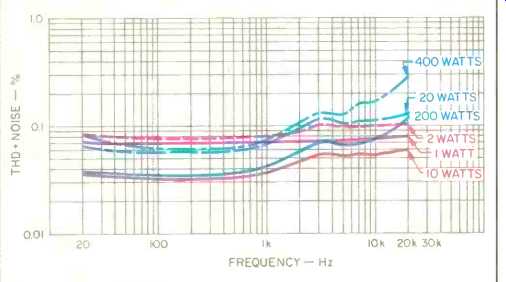
Fig. 1--THD + N vs. frequency for power levels of 1, 10 and 200 watts into
8 ohms, and 2, 20 and 400 watts into 4 ohms.
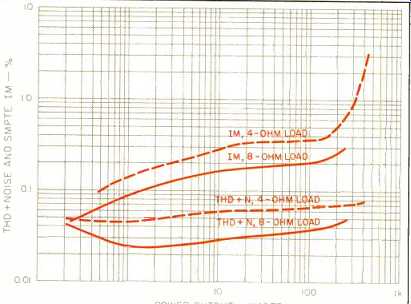
Fig. 2--Distortion vs. power output, showing THD + N at 1 kHz (measurement
bandwidth is 400 Hz to 80 kHz) and SMPTE IM, for 8-ohm and 4-ohm loads.
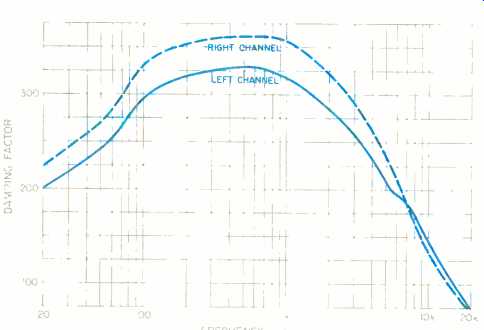
Fig. 3--Damping factor vs. frequency.
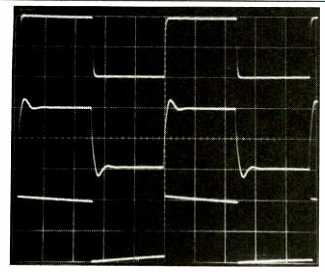
Fig. 4--Square-wave response. Top trace, 10 kHz into 8-ohm resistive load;
middle trace, same as top, with 2-uF capacitor across load; bottom trace,
40 Hz. Scales: Vertical, 5 V cm; horizontal, 20 µS/cm for 10-kHz traces,
5 mS cm for 40-Hz trace.
Total harmonic distortion plus noise was measured as a function of power, frequency and load (Fig. 1). The supplied 6-A speaker fuses had to be replaced with 10-A fuses in order to measure full power into 4-ohm loads. Figure 2 shows SMPTE-IM distortion and THD + N at 1 kHz; when both channels are driven, there is more distortion, especially IM, in the right channel than in the left. I measured another sample and it too had more IM in the right channel caused, it turns out, by the way internal ground paths are handled. If one drives the channels individually, the results are more equal; the IM of the left channel measures about one-half the value obtained for the right channel when both channels are driven. The nature of the IM distortion is essentially all even harmonic, indicating that the dominant nature of the Sixty Ten's nonlinearity is even harmonic.
Crosstalk between channels was found to be quite sym metrical, virtually the same whether leakage was measured from the right channel into the left or vice versa. It ranged from -56 dB at 10 Hz to a low of -82 dB at 1 kHz, rising to -79 dB at 10 kHz, -70 dB at 30 kHz, and -67 dB at 50 kHz. Signal-to-noise ratio (IHF) was -83.6 dB for the left channel and -85.6 dB for the right.
Damping factor versus frequency is shown in Fig. 3. I have no ready explanation for the fall-off in damping factor below 400 Hz.
The Sixty Ten is somewhat faster than many solid-state amps, having a rise and fall time of 1.2 uS that stays constant up to clipping into 8-ohm loads. Frequency response was down 0.5 dB at 10 Hz and 100 kHz.
Square-wave response is shown in Fig. 4. The top two traces show a 10-kHz square wave into 8 ohms, without (top) and with (middle) 2µF of capacitance across the 8-ohm load. The bottom trace is 40 Hz.
Dynamic headroom (IHF) was 1.85 dB into 8 ohms and 1.6 dB into 4 ohms, equivalent to 306 and 578 watts rms, respectively. Clipping headroom was 1.14 dB into 8 ohms and 0.61 dB into 4 ohms, equivalent to 260 and 460 watts.
For peak current-delivery measurements, I used the same IHF tone-burst signal used for the dynamic-headroom tests.
The amplifier channel under test was loaded with 0.1 ohm. Under these conditions, I was able to push the amp, with one channel driven, to a voltage swing of ± 10 V before visible distortion occurred. This translated to ± 100 amperes peak! No slouch at current delivery, the Sixty Ten.
Use and Listening Tests
Equipment used to evaluate the sonic aspects of the Sixty Ten included: an Infinity air-bearing turntable and arm; Koetsu Black (EMC-1B) cartridge; Dyna PAS-2, conrad-johnson PV5 and GC/BHK preamps; conrad-johnson Premier 5, Robertson Forty Ten and Mark Levinson ML-9 power amps; Infinity RS IIB and Snell Type A-III speakers, and Stax SR-X/Mk3 headphones.
For my first listening checks, I used the Sixty Ten with the Dyna PAS-2 and the Infinity speakers while playing tapes; I felt that the sound was quite good. The amp was then used to drive the woofers of a friend's Snell Type A-III speakers (he uses non-feedback tube power amps of 100 watts per channel, designed by Gordon Mercer, to drive the Snells' mids and tops). Over a period of time, we tried various other solid-state amps on the woofers too. The Sixty Ten emerged as the best-sounding bass amp in his setup; its sound blended the most homogeneously and musically with the rest of the range, especially in the crossover region. The smaller Forty Ten had about the same qualities when used as a bass amp in this system, but with less power.
Next, I listened to the Sixty Ten with the GC/BHK preamp and the Infinity RS IIB speakers. It delivers excellent dynamics and dynamic contrast, and has enormous power and punch. Spectral balance is good, with a smooth and non irritating high end. Spatial replication and the feeling of air and space around instruments is not as good as with the best tube power amps, but is still good, as solid-state amps go. In comparison with the Forty Ten, the Sixty Ten's bass is a little rounder and its high end is a little softer sounding, with a little more upper-midrange prominence. In contrast to the Robertson amps, the conrad-johnson Premier 5s had a greater feeling of space and in-the-room "thereness." All in all, I like the Robertson amps, and must add them to my small list of very listenable solid-state power amplifiers.
-Bascom H. King
(Audio magazine, Feb. 1986)
Also see:
SAE Model 2922 Integrated Amplifier (Mar. 1979)
SAE Model 5000 Impulse Noise Reduction System (June 1977)
= = = =